White-tailed Deer Field Studies
Food Habits
One of the first studies on the Kerr WMA investigated the diet of a white-tailed deer. Biologists looked at both what deer ate with no competition from other animals and what deer chose under heavy competition by livestock and other deer. A deer was placed in a 100-acre enclosure and an observer recorded each plant that was consumed by forage class (forbs, browse and grass). They found that, under no competition, deer prefer forbs (herbaceous flowering plants) when they were available, but relied heavily on browse when forbs were absent. Grasses actually made up a very small portion of the diet throughout the year. Under heavy competition, as forb availability quickly declined, deer primarily consumed browse plants while only slightly increasing their intake of grass. The digestive system of a deer is not capable of processing large amounts of mature grass, and they generally only consume grass when it is more digestible which is in the early growth stages. It was discovered that exotics and most classes of livestock, while also utilizing forbs and browse, will consume a much larger amount of grass in their diets. It was realized that since these other animals could make use of all three classes of forage that they had a competitive advantage over white-tailed deer that primarily used only two forage classes.
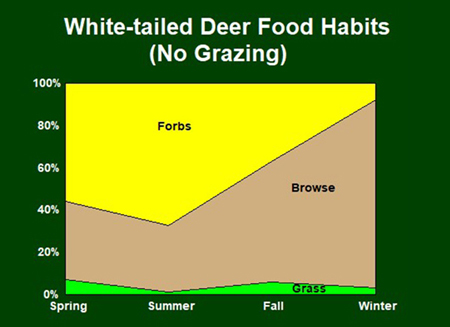
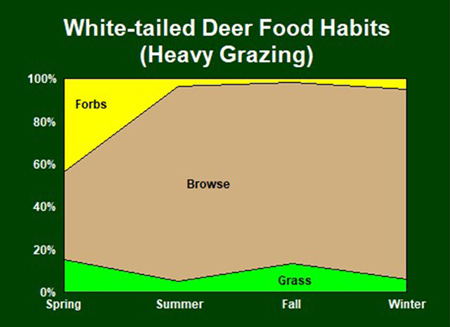
White-tailed deer food habits charts
Further diet research revealed that, within each forage class, certain plants received different levels of preference (Cross, 1984). Deer appeared to select some plants over others. Much of this selection is dictated by nutritional value, availability, taste and digestibility of a plant which could change over the course of a year. It is important to note that, even though deer prefer certain plants, they require and consume a variety of plants to meet their nutritional needs. For example, in the winter sampling period researchers discovered that while a few select plants made up a larger portion of the diet, they recorded over 60 total plant species. Therefore, it is imperative to manage for a diversity of plants on the landscape. Based on these diet studies, we developed a list of common plants found on the Kerr WMA and ranked them by white-tailed deer preference.
Cross, D. (1984). The food habits of white-tailed deer on the Kerr Wildlife Management Area in conjunction with prescribed burning and rotational grazing systems. [Unpublished masters thesis]. Southwest Texas State University.
Effects of Public Hunts on Mature Deer Movements
Staff fitting a mature deer with a GPS collar.
We examined movement patterns and home range of adult deer on the Kerr Wildlife Management Area (KWMA) during public hunts from 2013-2016. Thirty mature (> 3.5 years old) deer (16 male, 14 female) were captured and fitted with GPS collars. The KWMA was divided into two units and hunting was restricted to one unit each season to allow us to compare behavior of hunted and un-hunted deer. Home ranges and movement activity were measured during each hunt. Overall, we found no consistent evidence that hunting pressure effected home range or activity rates. Activity levels were highly variable among individuals and between years. Males showed higher activity levels than females. We also discovered that buck activity tended to be higher in the morning hours and that they stayed active until about noon, while the does stay fairly active throughout the entire day. During the fall breeding season, bucks ranged over several hundreds of acres, but reduced their range drastically by mid to late winter. The average annual home range was 738 acres for bucks and 300 acres for does. Data from this study on timing of peak activity for white-tailed deer and insight on the resultant behavior of deer when exposed to hunting pressure is informative to hunters pursuing mature male deer.
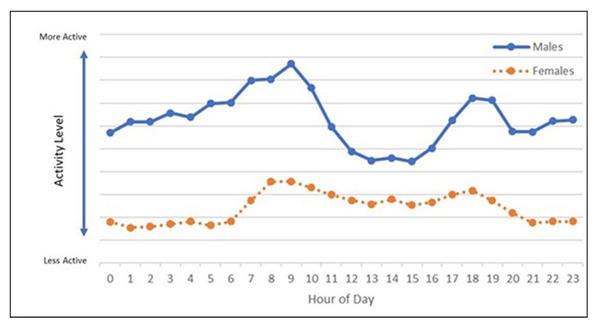
Average daily activity levels by hour for male and female deer on the KWMA during the 6 week hunt period (November to December) for entire four year study 2013 to 2016.
Unmanned Aerial Vehicle Surveys
The importance of managing white-tailed deer populations has long been understood. A big component of management is accurately estimating populations so that effective management decisions can be formulated. There are several survey and census methods available to managers, but each one has pros and cons. With the advancements in technology, we are beginning to see more potential applications to population survey methods. One such method is the use of Unmanned Aerial Vehicles (UAV), or drones, equipped with thermal imaging for monitoring and estimating wildlife populations. However, this novel method has not been adequately tested to understand its effectiveness. We completed a pilot study to test the accuracy and precision of utilizing a UAV equipped with a thermal camera to conduct a complete count of a known population of white-tailed deer in December 2019. The surveys were conducted in both the morning and evening for 3 consecutive days in early December. Both thermal and RGB (real color) videos were recorded for post survey viewing by 3 observers. Preliminary conclusions from the study shows some promising results for morning surveys using thermal video for detections and using RGB (real color) video for confirmation and sex identification. This research is ongoing and currently being replicated with different deer densities.
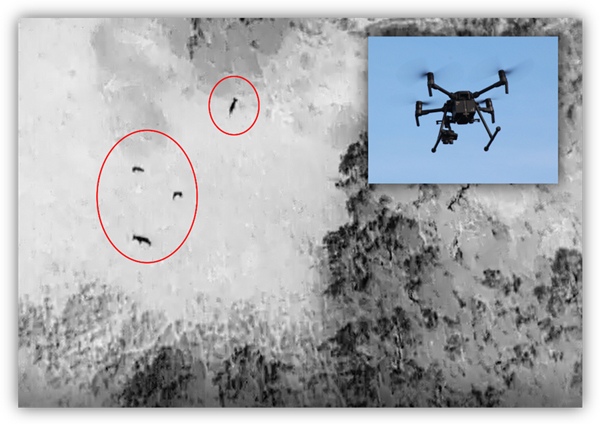
Unmanned aerial vehicle and survey photo.
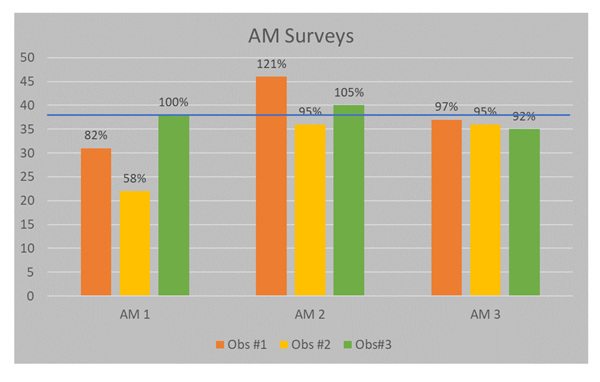
Graph shows some preliminary results from 2019 drone survey pilot study. Three observers counted deer from recorded thermal videos for three different AM study periods. Percentages represent the percent of the known population (blue line) that were observed by each observer for each survey.